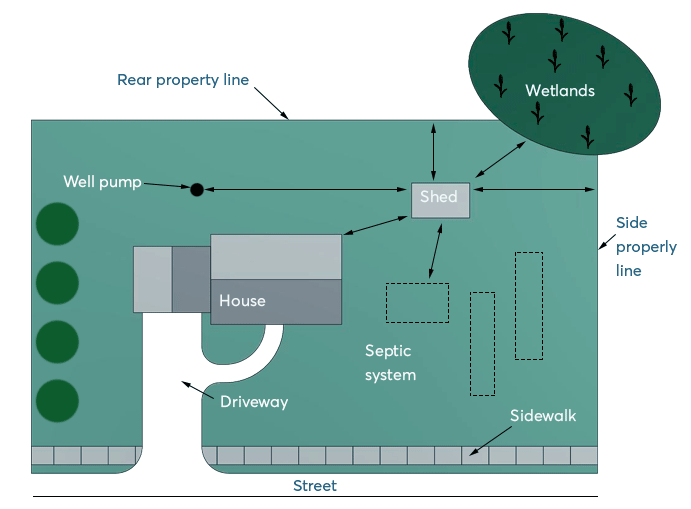A very important, but often overlooked, step in building a backyard storage shed is selecting the best spot on your property to construct the shed. This may not seem like a very difficult challenge, but if you pick the wrong spot, the shed can become inaccessible, unusable, and will begin to deteriorate prematurely. Here are several tips for choosing the best building site for your shed.
Maintain Setback Distances

Another important consideration when siting a shed is adhering to the proper setback requirements set forth by your town’s building department. These ordinances establish how far away the shed must be from such things as:
- Side, front, and rear property lines
- Wetland areas
- Easements
- Streets, driveways, and sidewalks
- Swimming pools
- Septic tanks and leach fields
- Power lines and telephone poles
Setback distances vary widely from town to town and can range anywhere from about 10 ft. (rear lot line) to 100 ft. or more (wetlands). So, before choosing your shed location, contact the local building department and ask for the proper setback distances.
Locations to Avoid
Never choose a building site that’s located at the bottom of a hill, in a low-lying area, or where water regularly collects. If you do, the area in front of the shed will become a muddy mess after every rainstorm, making it difficult to get to the shed. Plus, exposing a shed to all that excessive moisture will promote mold and mildew growth, and cause wood to rot, paint to blister, and hardware to rust. So, pick a building site that’s slightly elevated or at least located in an area that dries out quickly after a rainstorm.
It’s also smart not to build your shed in an area where it’s completely surrounded by trees. The trees will prevent the shed from receiving adequate sunshine and wind, creating the perfect environment for mold and mildew. The shed roof can be damaged by falling branches, and rodents are much more likely to move into a shed that’s built in a heavily wooded area.
Allow for Easy Access
Many homeowners build their sheds in the back corner of the lot, far from the house. And there’s nothing particularly wrong with that unless you use the shed all the time. For example, if the shed is used to store a lawn tractor or for a specific activity, such as potting plants or woodworking, then building it far from the house is fine.
But, if the shed will be used on a daily basis, build it closer to the house to avoid having to trudge across the yard every time you need something from the shed. And as a bonus, your kids will be much more likely to put away their bikes, toys, and sports equipment.
Select a Sunny Site
Building on a sunny site helps keep the shed dry, which greatly reduces problems caused by excessive moisture, including mold, mildew, and wood rot. Plus, a sunny location allows natural light to stream into the shed, illuminating the interior. To gain the most amount of sunlight, position the shed so that the wall with the largest windows or widest doorway faces south.
Apply for a Building Permit
Once you’ve selected the perfect spot to build your shed, go to the town hall and apply for a building permit. The building inspector will then come out to your property to inspect—and hopefully, approve—the building site. There are many reasons why your chosen site might not be approved but don’t worry, the inspector will suggest another suitable site.
 Joseph Truini is a host on the Today’s Homeowner TV show and co-hosts the weekly Today’s Homeowner Radio Show. He has written three best-selling shed-building books and lives in Roxbury, Connecticut.
Joseph Truini is a host on the Today’s Homeowner TV show and co-hosts the weekly Today’s Homeowner Radio Show. He has written three best-selling shed-building books and lives in Roxbury, Connecticut.